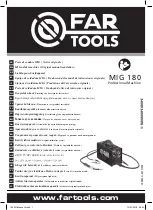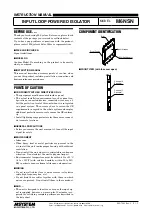
18
CUTTING CHAINS
CM Hoistaloy
®
load chain is hardened and it is difficult to cut.
The following methods are recommended when cutting a
length of new chain from stock or cutting off worn chain.
Figure 14. Cutting Chain by nicking
1. Use a grinder and nick the link on both sides (Figure 14),
then secure the link in a vise and break off with a hammer.
2. Use a 7" minimum diameter by 1/8" thick abrasive wheel
(or type recommended by wheel supplier) that will clear
adjacent links.
Figure 15. Cutting Chain with a bolt cutter
3. Use a bolt cutter (Figure 15) similar to the H.K. Porter
No. 0590MTC with special cutter jaws for cutting hard-
ened chain (1" long cutting edge).
TESTING
Before using, all altered, repaired or used hoists that have
not been operated for the previous 12 months shall be tested
by the user for proper operation.
1. Test the unit without a load.
2. Test the unit with a light load of 50 pounds times the num-
ber of load supporting parts of load chain. Check to see
that the hoist operates properly and that the brake holds
the load when the control is released.
3. Test with a load of 125%* of rated capacity. Hoists in
which load sustaining parts have been replaced should
be tested with 125%* of rated capacity by or under the
direction of an appointed person and a written report pre-
pared for record purposes.
4. After test 3, check that the Protector functions. If the
L
L
!!
WARNING
Cutting chain can produce flying particles.
TO AVOID INJURY:
Wear eye protection. Provide a shield over chain to prevent
flying particles.
Protector™ permits lifting a load in excess of 200% of
rated load, it should be replaced.
*If the protector prevents lifting a load of 125% of rated
capacity, reduce load to rated capacity.
NOTE: For additional information on inspection and
testing, refer to Code B30.16 “Overhead Hoists”
obtainable from ASME Order Department, 22 Law
Drive, Box 2300, Fairfield, NJ 07007-2300, U.S.A.
REPLACEMENT PARTS
ORDERING INSTRUCTIONS
The following information must accompany all correspon-
dence or orders for replacement parts:
1. Hoist Model Number from identification label.
2. Serial number of the hoist stamped below identification
plate.
3. Voltage, Phase, Hertz from identification label.
4. Length of lift.
5. Key number of part from parts list.
6. Number of parts required.
7. Part name from parts list.
8. Part number from the parts lists.
If trolley replacement parts are ordered, also include the type
and capacity of the trolley.
NOTE: When ordering replacement parts, it is recom-
mended that consideration be given to the need for
also ordering such items as gaskets, fasteners, insula-
tors, etc. These items may be damaged or lost during
disassembly or just unfit for future use because of
deterioration from age or service.
L
L
!!
WARNING
Using “commercial” or other manufacturer’s parts to repair
the CM Valustar Hoist may cause load loss.
TO AVOID INJURY:
Use only CM supplied replacement parts. Parts may look alike,
but CM parts are made of specific materials or processed to
achieve specific properties.
Grinder
Nicks
For more information contact: Sievert Crane and Hoist, (708) 771-1600, [email protected], www.sievertcrane.com








































